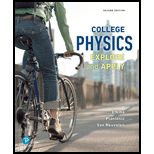
Concept explainers
Review Question 7.1 Assuming that Earth’s orbit around the Sun is circular, what information do you need to estimate the work done by the Sun on Earth while Earth travels 1000 km? Explain your answer.
The information needed to estimate the work done by the Sun on the Earth while Earth travels
Answer to Problem 1RQ
Solution:
No information is needed because work done by the Sun on the Earth is zero in this case.
Explanation of Solution
Introduction:
Work done by any force is defined as the product of force and the displacement in the direction of the force.
In this question, it is assumed that Earth’s orbit is circular, i.e., Earth’s displacement in the radial direction is zero at every point of the path.
Explanation:
When the orbit is assumed to be circular radius, it is constant at every point of the path, i.e., there is no displacement in the direction of the radius. Since, the Sun is at the center of this circular orbit, so the gravitational force between the Sun and Earth is always towards the center and along the radius.
The equation for the work done is given below.
Here,
In the case of a circular path, the angle between displacement and the force is
When
Conclusion:
Work done by centripetal force in case of circular motion is always zero. In this case, the Earth’s orbit is assumed to be circular, the gravitational force’s direction is always along the radius towards the center, i.e., the Sun. But, displacement along the radius is zero at every point of the path. Hence, the work done is zero.
Want to see more full solutions like this?
Chapter 7 Solutions
College Physics
Additional Science Textbook Solutions
Microbiology: An Introduction
Cosmic Perspective Fundamentals
College Physics: A Strategic Approach (3rd Edition)
Campbell Biology (11th Edition)
Chemistry: An Introduction to General, Organic, and Biological Chemistry (13th Edition)
- The drawing shows a crystalline slab (refractive index 1.995) with a rectangular cross section. A ray of light strikes the slab at an incident angle of 01 = 35.0°, enters the slab, and travels to point P. This slab is surrounded by a fluid with a refractive index n. What is the maximum value of n such that total internal reflection occurs at point P? Ме Buarrow_forwardWhat is the amount of M112 needed to breach a 5-foot thick dense concrete wall utilizing an internal charge placed in the center of the target?arrow_forwardA small postage stamp is placed in front of a concave mirror (radius = 1.1 m), such that the image distance equals the object distance. (a) What is the object distance? (b) What is the magnification of the mirror (with the proper sign)?arrow_forward
- Calculate the anti-clockwise torque and the clockwise torque of the system with the ruler and the washers. Record these values in Data Table 5. Ruler = 11.56 g, small washer = 1.85 g, large washer = 24.30 g. Calculate the % Difference in the Torques and record the values in Data Table 5. Is ΣAnticlockwise torque and Anticlockwise torque the same thing, are they solved in the same way?arrow_forwardA window washer stands on a uniform plank of mass M = 142 kg and length l = 2.80 m supported by 2 ropes attached at the ends of the plank. The window washer has a mass m = 68.0 kg. What is the tension in each of the ropes, T1 and T2, if the window washer's displacement from the center of mass of the plank is x = 0.930 m as shown in Figure 1: Window Washer Problem?arrow_forwardA man holds a double-sided spherical mirror so that he is looking directly into its convex surface, 33 cm from his face. The magnification of the image of his face is +0.17. What will be the image distance when he reverses the mirror (looking into its concave surface), maintaining the same distance between the mirror and his face? Be sure to include the algebraic sign (+ or -) with your answer.arrow_forward
- How do you draw a diagram of the ruler and mass system in equilibrium identifying the anti-clockwise torque and clockwise torque? How do I calculate the anti-clockwise torque and the clockwise torque of the system with the ruler and the washers, does it come from the data in table 4? Please help, thank you!arrow_forwardExample Double pane windows have two panes of glass (n = 1.5), with a layer of air sandwiched between them. If light from outside enters the first pane at an angle of 25° from the surface normal, what angle does it enter the house at? ☑ 3 5arrow_forwardDid your experiment results in Data Table 3 verify, to within a reasonable experimental error, the condition of equilibrium of Equation 6: Στanti-clockwise = Στclockwise? Support your response with experimental data. What does this Σ mean? My results do not show they are equal to each other, what does this mean then, and what does the data show? Thanks!arrow_forward
 Physics for Scientists and Engineers, Technology ...PhysicsISBN:9781305116399Author:Raymond A. Serway, John W. JewettPublisher:Cengage Learning
Physics for Scientists and Engineers, Technology ...PhysicsISBN:9781305116399Author:Raymond A. Serway, John W. JewettPublisher:Cengage Learning Principles of Physics: A Calculus-Based TextPhysicsISBN:9781133104261Author:Raymond A. Serway, John W. JewettPublisher:Cengage Learning
Principles of Physics: A Calculus-Based TextPhysicsISBN:9781133104261Author:Raymond A. Serway, John W. JewettPublisher:Cengage Learning College PhysicsPhysicsISBN:9781285737027Author:Raymond A. Serway, Chris VuillePublisher:Cengage Learning
College PhysicsPhysicsISBN:9781285737027Author:Raymond A. Serway, Chris VuillePublisher:Cengage Learning Physics for Scientists and Engineers: Foundations...PhysicsISBN:9781133939146Author:Katz, Debora M.Publisher:Cengage Learning
Physics for Scientists and Engineers: Foundations...PhysicsISBN:9781133939146Author:Katz, Debora M.Publisher:Cengage Learning Physics for Scientists and Engineers with Modern ...PhysicsISBN:9781337553292Author:Raymond A. Serway, John W. JewettPublisher:Cengage Learning
Physics for Scientists and Engineers with Modern ...PhysicsISBN:9781337553292Author:Raymond A. Serway, John W. JewettPublisher:Cengage Learning





